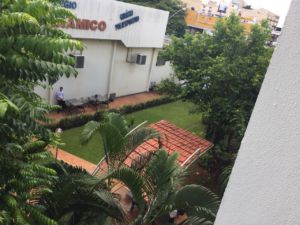Why do some Redwood students take the risk and leave their comfortable life to settle abroad? That would mean saying goodbye to home, school and friends, and saying hello to a foreign language, a different culture and completely new people.
According to the BBC, the world’s international student population in 2009 was 3.7 million and is increasing at a rate of 12 percent each year. In addition, in the March Bark survey, 37 percent of students self-reported considering going abroad for one year or more, while 30 percent of students know two to students who have done just that. This data shows that studying in a foreign country is fairly popular, but why is going abroad so appealing and what is it like to move away from the Marin bubble?
Sophomore Cassidy Rodgers gave insight on this question after moving to Barcelona, Spain. The motive behind the move was an offer from her mother’s job to settle somewhere new.
“I said yes [to moving] because I wanted to try a new experience and get away from living in a small town my whole life, get a new perspective,” Rodgers said.
Other students have moved abroad and had different reasons for doing so. Sophomore Olivia Lane decided to leave the U.S. for six months to go to live in Goiânia, located in the heart of Brazil. However, unlike Rodgers, she moved to improve her fluency in another language.

“I moved [to Brazil] to learn a little more about the country. I’m half Brazilian and my Portuguese was a little bit rusty, so I went there to get better at it,” Lane said.
Studying abroad has many benefits, which is a reason some students may choose to try something new and make the move. However, getting out of one’s comfort zone isn’t easy. Sophomore Will Gerstein, who moved to Madrid, Spain at the start of the school year, summarized his experiences in his new home.
“You have to be ready for everything to go wrong. It’s an adventure, stuff happens,” Gerstein said.
Although this may sound discouraging, Gerstein embraces it and doesn’t consider the challenge to be a downside. He has also found many advantages, such as becoming more mature.
“You rise to the occasion, being mature enough where my mom says, ‘Okay, be home at 2:30 in the morning.’ I’m mature enough to know where to go in the city because you can go a lot of places. I feel like I’ve definitely grown,” Gerstein said.
In fact, according to The Institute for International Education of Students (IES), 95 percent of students surveyed said learning in a foreign country made them more mature and 96 percent also believed it improved their self-confidence.
But what is living abroad actually like? Lane found that schooling is a major adjustment when transitioning to a new country, as it is more intense.
“There are only three years of high school [in Brazil] and I learned they do harder material because all classes you take are mandatory,” Lane said.
In contrast, according to Gerstein, school abroad is not necessarily more difficult for him. However, the structure of his school day is different from Redwood. For example, classes begin later in the morning, which he says attributes to the fact that the Spanish have a culture of staying up late.
“I have school from nine in the morning to 3:45 p.m.. I take public transportation, which is a bus, then a metro, and then I walk. I get home at 9 p.m., do some homework and go to bed,” Gerstein said.
According to Gerstein, the students at his international school, located in the suburbs of Madrid, will stay after school to complete homework in a “learning commons area,” which is a designated room for finishing assignments.
“Around 3:45 at Redwood, they push you out of the school. You’re out of the buildings, you want to get away. At my school, it’s the exact opposite. I would say around 75 percent of kids stay after school for an hour to two and a half hours,” Gerstein said.
Gerstein found that having a learning commons area has helped him do less work at home after soccer practice. The difference between the center at Gerstein’s school in Madrid and the Redwood library is that Gerstein’s teachers will offer support in finishing homework, whereas at Redwood, usually only student peer tutors offer help.
Schools are a place where cultural differences in people can be seen. Rodgers noted these discrepancies may be a result of the exposure and connections that foreigners have to the rest of the world. In her case, this may be due to Spain’s geography being conveniently located next to other European countries that are brimming with history and culture.
In addition, Spain attracts immigrants and travelers from all over the world, which increases contact with other cultures. For example, according to U.S. News, in 2017 between the months of January and June, Barcelona received 36.3 million tourists.

“People here [in Barcelona] have a better perspective of the world around them. When I was living in Marin, I was used to people not knowing what the rest of the world is like, but here peoples views of the world are so much bigger and brighter,” Rodgers said.
Rodgers isn’t alone in feeling this way after moving. According to the IES, 95 percent of their students surveyed felt that studying abroad had a lasting impact on their worldview, while an additional 94 percent said that their move continues to influence their interactions with other cultures.
According to Lane, she too felt cultural differences between Americans and foreigners. She said the people she met in Brazil were not only accepting of her, but were also willing to give up their time to help her transition. Lane does not feel that this is common in American culture, so she was pleasantly surprised to receive aid from locals.
“They always ask ‘Oh, do you need help with something?’ or ‘Do you want me to translate that for you?’” Lane said.
Unless settling abroad means moving to a country where the first language is English, the language barrier can be an issue. However, Rodgers found that she was able to pick up enough of the Spanish language to get by.
“When you’re out and about you have to learn Spanish and you learn it in school too, in fact a lot more than in the States. I’m not advanced yet, but I think I have a good shot at becoming good at Spanish before I come home,” Rodgers said.
Nevertheless, Rodgers has found that simply knowing Spanish is not as helpful as she had hoped, as the ethnic language of Spain’s Catalonia region, which includes Barcelona, is Catalan.
“Everyone here speaks Catalan. I was not prepared for that. I honestly assumed I could come to Spain, speak Spanish, and be all good, but in Barcelona everyone speaks Catalan and it’s very confusing,” Rodgers said.
While every family has their own reason for taking time to live abroad, Rodgers believes the main explanation for moving is to experience new cultures.
“Students want to experience more. They want to see more of the world and see what it is like to live in a different place with a different culture,” said Rodgers.
The process of moving across the world may seem intimidating, especially when the time comes to transfer back to Redwood. Course selection and grades are a main priority for some Redwood students, but according to Lane, the process of transferring back and continuing with her American education was not difficult at all.

“The major thing you have to worry about is credits for graduating. I have to take extra English credits and have enough hours for English, but I think it was really easy to transition,” Lane said.
Although Rodgers will not be returning to Redwood until the fall semester of the next school year, she does not want to worry about the stress of her return.
“One of my worries was if my courses would line up, but honestly you can worry about all of that later. Just being able to go abroad and learn at a different school is amazing. I haven’t been worrying about the future because I’m having fun now and experiencing it now,” Rodgers said.























